Manuscripts Etc.
| CLOSE WINDOW |

|
The following items are drawn from the William Faulkner Foundation Collection at the University of Virginia's Albert and Shirley Small Special Collections Library (http://small.library.virginia.edu/). |
|
The story Faulkner repeatedly told about writing Sanctuary may be almost as well known as the novel itself. He told it several times to audiences at the University of Virginia – you can hear one such account in the Audio Clips. In brief it goes like this: in 1929, after writing four novels which didn't sell, and about to take on the responsibilties of marriage, he decided to write "the most horrific story I could imagine" as a way to attract an audience; after his publisher told him it was so lurid that they would "both be in jail" if they printed it, the author forgot about it; about 18 months later, however, the publisher surprised him with a set of galley proofs for the novel and Faulkner, ashamed of its baseness, set to work in late 1930 to revise the "horrific story" into something that would lie more quietly on his artistic conscience. There is some truth to this account, but the the surviving manuscript and typescript in the Faulkner Foundation Collection reveal that on the whole it's another of Faulkner's fictions. Both manuscript and typescript preserve the 1929 version of Sanctuary, which Faulkner often said he wrote in about three weeks, implying how carelessly he tossed it off. But the dates he wrote in hand on the title page of the typescript (below) indicate it took more like five months: "January - May 1929."
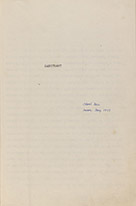 And the evidence suggests that Faulkner worked on that first version as intensely as on any of his books. The 134-page manuscript is not the earliest version, as we can tell from the many passages that have been cut from a still earlier version and pasted onto these new pages. Both the pasted pages and the new ones are heavily revised. Faulkner worked especially hard at finding the right organization for the narrative. As Joseph Blotner notes, all but 34 of these pages have multiple page numbers in their upper left hand corners; according to Noel Polk, one single page was renumbered more than 20 times. Faulkner also kept shifting around the book's chapter structure: 16 of its 27 chapters were tried in more than one place. As you can see below, he even thought of beginning this 1929 version in at least three different places. Left: with Temple Drake at college, with a glimpse under her dress that, as Richard Godden notes, echoes the image that inspired The Sound and the Fury, the novel Faulkner had just finished when he began Sanctuary: the image of Caddy Compson climbing the tree. Center: with Temple on the witness stand at Lee Godwin's trial, immediately after perjuring herself to insure his conviction for murder and rape (with this beginning Faulkner mentions the corncob almost immediately). Right, Faulkner's "final" choice: Horace looking at Ruby outside of Goodwin's jail cell (of course, when he revised the galleys in 1930 he changed his mind again). 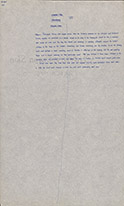 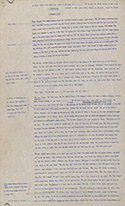 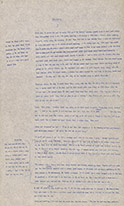 The proofs that Faulkner revised so drastically in 1930 are in the Humanities Research Center at the University of Texas. Virginia's manuscript, and the typescript that follows it closely, can only tell part of the story of the novel's conception and gestation. But from them it's clear that the most substantial effect of Faulkner's revisions was not to make the story less lurid - the later text is in fact more graphic and violent - but to change the role that Horace Benbow plays in it. In the 1929 text, Horace comes across as a middle-aged Quentin Compson, deeply obsessed with female sexuality, and with his sister in particular. The narrative is in the third-person, but it often stays almost as close to Horace's consciousness as the stream-of-consciousness technique Faulkner deployed in The Sound and the Fury. Below is a sequence from the original second chapter, which runs together an episode involving Horace and his step-daughter Little Belle in Kinston with two conversations from ten year's earlier in Jefferson – with future wife, Belle, about his Freudian relationship with his sister Narcissa (page 7), and with Narcissa herself, begging her not to marry (page 8). The way this sequence jumps around in time and space resembles the discontinuous narrative in both Benjy and Quentin's sections. When he typed up the manuscript, Faulkner divided parts of this sequence into Chapters II and V, making the story a bit easier to follow, but the material itself remained. However, when he revised these passages in 1930, Faulkner cut the lines in which Belle tells Horace he's "in love with [his] sister" as well as the scene with Narcissa. More significantly, he moved the narrative's perspective outside Horace's point of view; in the published novel Horace tells rather than thinks the scene with Little Belle, and the novel's fourth major female character, Ruby, repeatedly comments on the "craziness" of what he is saying. As is frequently the case in the 1929 version of the novel, this sequence is effectively set inside Horace's consciousness (note also how many lines are pasted in from an earlier manuscript): 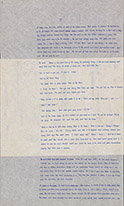 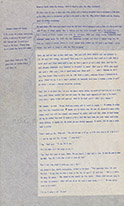 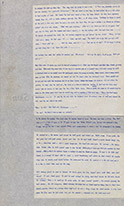 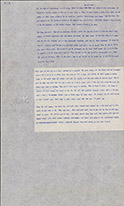 Much of the 5-page manuscript sequence below was also cut as Faulkner revised in 1930. In the process he eliminated the striking way in which the original version, through a series of photographs, linked "the most horrific story I could imagine" to the history of the Sartoris family which he had glamorized in the novel where Horace and Narcissa appeared the year before, Flags in the Dust|Sartoris (pages 26 and 27; note also the various page and chapter numbers). Although Popeye is several times referred to as "the black man," the published Sanctuary largely excludes the issue of race, but this sequence also includes a racially benighted exchange between Aunt Jenny and her servant Saddie, who is reminiscent of the character Topsy in Uncle Tom's Cabin; both Saddie and her brother Sandy were cut from the novel in revision. And Belle, who is obviously somewhat familiar with psychoanalysis, a popular fad in the 1920s, would certainly have been interested in the dream that Horace has while sleeping in the house that belonged to his sister's husband (page 30). The dream merges all the women in Horace's life – sister, wife, step-daughter and Ruby, the prostitute in the "calico dress" he met at the Frenchman's Place – into one frightening female figure, who morphs into yet another woman – Horace's mother – who then vomits the same "black stuff" that flowed out of "Bovary's mouth." After Faulkner's 1930 revisions, the only vestige of this incredibly over-determined dream is the copy of Flaubert's Madame Bovary that Horace takes with him when he flees wife and step-daughter and tries to go home again. 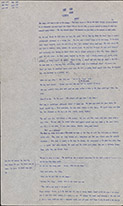 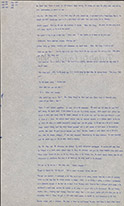 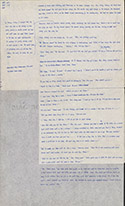 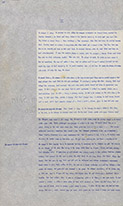 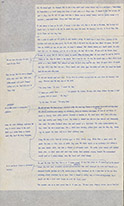 When in those galley proofs Faulkner revised the story away from Horace's anguished and confusing consciousness, he made it, if anything, more saleable. The way he revised the ending is another step in that direction. Before the anti-climax of Horace's return to Belle, the published text climaxes with the violent scene of Goodwin's lynching in the center of town. The 1929 version follows the trial with an exchange of letters between Horace and Narcissa (below left and center), in which Narcissa says that, although "they were getting ready to lynch" Goodwin, he was taken away in time and so "Jefferson was spared that" (page 134). Both manuscript and typescript end with Popeye being hanged for a crime he didn't commit, juxtaposed against Temple Drake in Paris, but the 1929 version does not include the novel's account of Popeye's syphilitic childhood, and in the earlier version Faulkner interpolates the two paragraphs describing the Luxembourg Gardens inside the scene of Popeye's execution (below right): 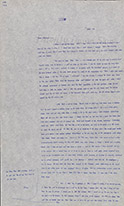 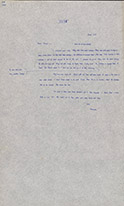  As noted, the 358-page carbon typescript we have is very close to the manuscript. But among its noteworthy features is the fact that at some point Faulkner himself carefully bound the pages together into a homemade book – which suggests he didn't despise this text as much as his own representations claim. Even in the typescript he is still wrestling with the novel's organization: chapters III and IV, which he reversed several times in the manuscript (below left), are switched yet again. About a dozen pages of the carbon were typed on the back of pages from the manuscript that pre-dates the extant one. Most of these also reveal the extent to which Faulkner originally told the story from Horace's perspective (below center; one line of this passage was re-used in the second manuscript [see page 28 above], but it is shifted from consciousness to dialogue). One other typescript passage that I think is worth noting occurs on page 62 (originally page 41, below right): when Horace first approaches the Gothic ruin of the Old Frenchman place, his thoughts carry readers away to the Old South, thus linking "the vanished pagentry of a dream" and the ladies who populated it in "hoops and crinoline," to the novel's nightmare of modernity: Memphis gangsters, cars, prostitutes and jazz-ing in both its original significations. 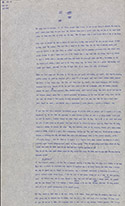 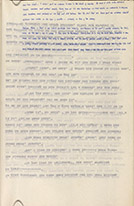 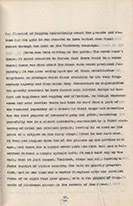 The character of Popeye already existed in Faulkner's imagination half a decade, at least, before he began writing Sanctuary. In the unpublished story "The Big Shot" that Faullkner wrote in the mid-1920s, he's a sociopathic bootlegger who inhabits the criminal underworld in New Orleans. Faulkner seems to have based him on an actual gangster with the same nickname, though it's not clear how many of the characteristics that his Popeye exhibits in both the story and the novel - including impotence and an aversion to drinking the alcohol he distributes - are also shared by Neal Kerens Pumphrey, the real Popeye's real name. You can meet Faulkner's first iteration of Popeye's character in the ten pages from the typescript of "The Big Shot" included in the Manuscripts Etc. display for Absalom, Absalom!. (The existence of these two earlier Popeye's, one real and one imaginary, answers a question students sometimes ask, i.e. does the character in Sanctuary owe anything to the cartoon character, Popeye the Sailor Man? That Popeye was created by Elzie Crisler Segar, in the nationally syndicated comic strip the Thimble Theatre. Popeye joined the cast of that comic on January 17, 1929, right around the time Faulkner began the novel - but years after he featured his Popeye in the short story. On the other hand, given the strangely prominent role that a bottle of "olive oil" plays in Popeye's early life in the novel's last chapter (305), Faulkner may have intended to make an oblique acknowledgment to the cartoon; Segar created Olive Oyl in 1919, and she becomes Popeye's girl not long after he was introduced. However, there is no obvious answer to the question: why might Faulkner associate his vicious Popeye with Segar's comic hero? SOURCES: Joseph Blotner,Faulkner: A Biography (New York: Random House, 1974); Richard Godden, "What Price a 'Cheap Idea'?: Money, Sanctuary, and Its Intertexts," a keynote address at the July 2017 Faulkner and Yoknapatawpha Conference (University of Mississippi); (Gerald Langford, Faulkner's Revision of Sanctuary: A Collation of the Unrevised Galleys and the Published Book (Austin: University of Texas Press, 1972); Noel Polk, William Faulkner: Sanctuary, The Original Text (New York: Random House, 1981). Citing this source: |
